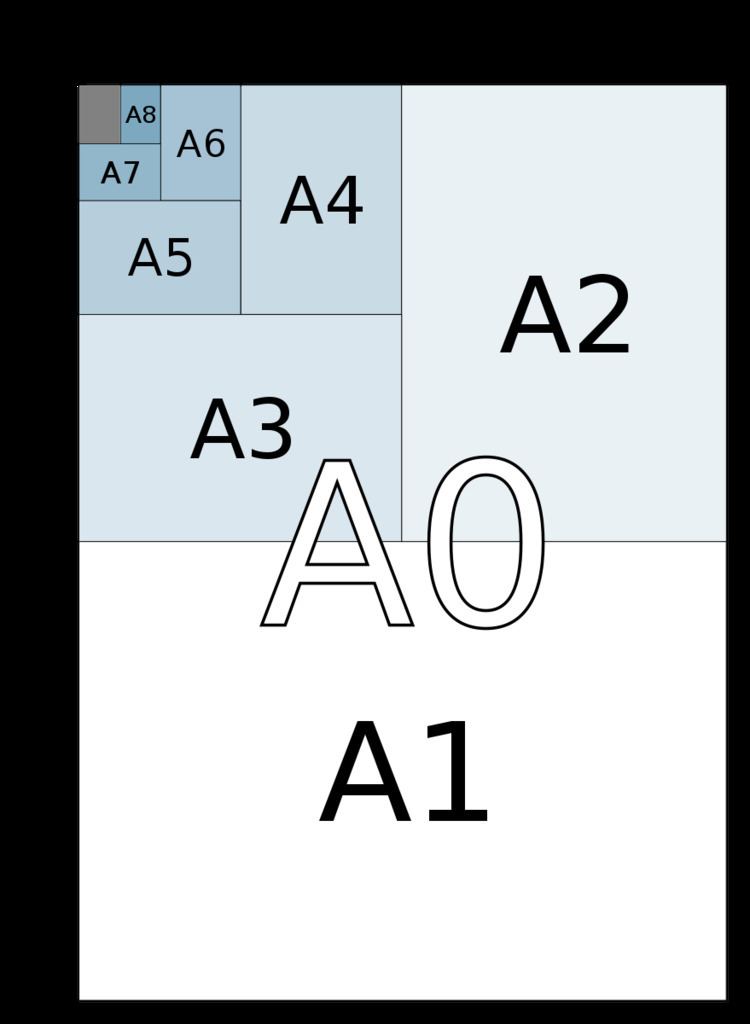 | ||
ISO 216 specifies international standard (ISO) paper sizes used in most countries in the world today, although not in Canada or the United States. The standard defines the "A" and "B" series of paper sizes, including A4, the most commonly available size. Two supplementary standards, ISO 217 and ISO 269, define related paper sizes; the ISO 269 "C" series is commonly listed alongside the A and B sizes.
Contents
All ISO 216, ISO 217 and ISO 269 paper sizes (except some envelopes) have the same aspect ratio, 1:√2, at least to within the rounding to whole numbers of millimetres. This ratio has the unique property that when cut or folded in half widthwise, the halves also have the same aspect ratio. Each ISO paper size is one half of the area of the next larger size.
History
In 1786, the German scientist Georg Christoph Lichtenberg described the advantages of basing a paper size on an aspect ratio of
The main advantage of this system is its scaling. Rectangular paper with an aspect ratio of
The ISO system of paper sizes exploit these properties of the
This system also simplifies calculating the weight paper. Under ISO 536, paper's grammage is defined as a sheet's weight in grams (g) per area in square metres (abbreviated g/m2 or gsm). Since an A0 sheet has an area of 1 m2, its weight in grams is the same as its grammage. One can derive the grammage of other sizes by arithmetic division in g/m2. A standard A4 sheet made from 80 g/m2 paper weighs 5 g, as it is 1⁄16 (four halvings, ignoring roundings to exact mm) of an A0 page. Thus the weight, and the associated postage rate, can be easily approximated by counting the number of sheets used.
ISO 216 and its related standards were first published between 1975 and 1995:
A series
Paper in the A series format has a
The most frequently used of this series is the size A4 which is 210 mm × 297 mm (8.27 in × 11.7 in) and so almost
The geometric rationale behind the square root of 2 is to maintain the aspect ratio of each subsequent rectangle after cutting or folding an A series sheet in half, perpendicular to the larger side. Given a rectangle with a longer side, x, and a shorter side, y, ensuring that its aspect ratio,
The formula that gives the larger border of the paper size An in metres and without rounding off is the geometric sequence:
The exact millimetre measurement of the long side of An is given by
B series
The B series is defined in the standard as follows: "A subsidiary series of sizes is obtained by placing the geometrical means between adjacent sizes of the A series in sequence." The use of the "geometric means", means that each step in size: B0, A0, B1, A1, B2 … is smaller than the previous by an equal scaling. As with the A series, the lengths of the B series have the ratio 1:√2, and folding one in half gives the next in the series. The shorter side of B0 is exactly 1 metre.
There is also an incompatible Japanese B series which the JIS defines to have 1.5 times the area of the corresponding JIS A series (which is identical to the ISO A series). Thus, the lengths of JIS B series paper are
For the ISO B series, the exact millimetre measurement of the long side of Bn is given by
C series
The C series formats are geometric means between the B series and A series formats with the same number (e.g., C2 is the geometric mean between B2 and A2). The width to height ratio is as in the A and B series. The C series formats are used mainly for envelopes. An A4 page will fit into a C4 envelope. C series envelopes follow the same ratio principle as the A series pages. For example, if an A4 page is folded in half so that it is A5 in size, it will fit into a C5 envelope (which will be the same size as a C4 envelope folded in half). The lengths of ISO C series paper are therefore 8√2 times those of A-series paper – i.e., about 9% larger.
A, B, and C paper fit together as part of a geometric progression, with ratio of successive side lengths of 8√2, though there is no size half-way between Bn and A(n − 1): A4, C4, B4, "D4", A3, …; there is such a D-series in the Swedish extensions to the system.
The exact millimetre measurement of the long side of Cn is given by
Tolerances
The tolerances specified in the standard are:
These are related to comparison between series A, B and C.
Application
The ISO 216 formats are organized around the ratio 1:√2; two sheets next to each other together have the same ratio, sideways. In scaled photocopying, for example, two A4 sheets reduced to A5 size fit exactly onto one A4 sheet, and an A4 sheet in magnified size onto an A3 sheet; in each case, there is neither waste nor want.
The principal countries not generally using the ISO paper sizes are the United States and Canada, which use the Letter, Legal and Executive system. Although they have also officially adopted the ISO 216 paper format, Mexico, Panama, Venezuela, Colombia, the Philippines, and Chile also use mostly U.S. paper sizes.
Rectangular sheets of paper with the ratio 1:√2 are popular in paper folding, such as origami, where they are sometimes called "A4 rectangles" or "silver rectangles". In other contexts, the term "silver rectangle" can also refer to a rectangle in the proportion 1:(1 + √2), known as the silver ratio.
